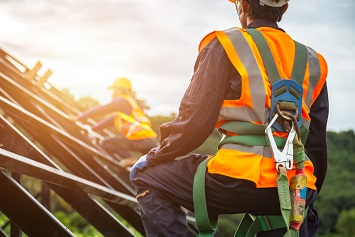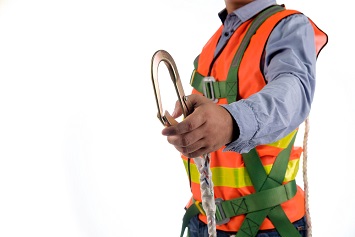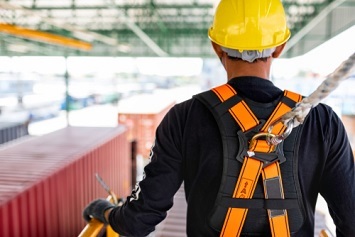Have you become complacent about safety hazards like falls while focusing on the health hazards of the COVID-19 pandemic? The consequences may be tragic—falls from height are one of the “Fatal Four” safety hazards, along with caught-in or -between, electrocution, and struck-by hazards—and failure to comply with fall protection regulations can result in citations and fines from the Occupational Safety and Health Administration (OSHA) and even inclusion in the agency’s severe violator enforcement program.
Fatalities caused by falls from elevation remain a leading cause of death for construction workers, accounting for 320 of 1,008 construction fatalities, according to the latest Bureau of Labor Statistics data.
Fall protection is a top priority for both OSHA and the National Institute for Occupational Safety and Health (NIOSH), as well as professional safety groups like AIHA (formerly the American Industrial Hygiene Association), the American Society of Safety Professionals (ASSP), and the National Safety Council (NSC).
ASSP last year renewed a research and workplace safety promotion partnership with NIOSH that included plans for continued research into fall protection measures for young, immigrant construction workers. ASSP and NIOSH already had found that young (under 25 years old) Latino immigrants working at construction companies with fewer than 20 employees are vulnerable to injury and illness. Factors that make these workers vulnerable include small companies’ lack of capacity, knowledge, and robust safety management and training systems and adolescents’ risk-taking and lack of knowledge, skills, and job training, as well as immigrants’ unfamiliarity with the risks and safety practices of American workplaces. ASSP and NIOSH plan to offer safety professionals effective, culturally tailored training programs they can use to prevent falls among these workers.
NIOSH, NSC Research
NIOSH has extensively researched fatal falls through its Fatality Assessment and Control Evaluation (FACE) program. FACE program members have found that contributing factors in falls from roofs include worker inexperience or a lack of training, no fall protection program or fall protection equipment used, the lack of fall arrest system anchorage points or incorrect anchorage method used, incorrect lifeline length, and working in inclement weather.
Worker inexperience and lack of training also contribute to ladder falls, as do improper ladder selection or improper use of ladders; not extending a ladder above the roof line; and not setting up a ladder on a flat, level surface or setting it up at an improper angle. The lack of a fall protection program and training, as well as worker inexperience, also contributes to falls from scaffolding. Other contributing factors include unstable work surfaces, improper scaffolding construction, no use of guardrails, and unlocked scaffolding wheels when workers mount a work platform.
The NSC also has worked to address fall from heights through its “Work to Zero” initiative. Researchers looked at hazardous workplace situations that most often lead to fatalities to get at contributing risk factors and identify technologies that environment, health, and safety (EHS) professionals might be able to use to address them.
The group produced its first report earlier this year—“Safety Technology 2020: Mapping Technology Solutions for Reducing Serious Injuries and Fatalities in the Workplace.” The report looked at 18 hazardous situations in which workers are most likely to die and provided anywhere from five to eight potential technology solutions for each situation.
In addition to working at heights, the report looked at cleaning, confined space entry, construction and installation, electrical work, emergency response, excavation, heavy equipment operation, hot work (such as welding), inspections (or checking), loading and unloading, logging equipment operation, machinery operation, process safety operations, repair and maintenance, tending a retail establishment, vehicle-pedestrian interactions, and workplace violence.
Researchers found the most promising technology solutions for working at heights were:
- Mobile anchor points that can allow workers to attach fall arrest systems to a roof with weighted anchors and do not require penetrating the structure.
- Aerial lifts and platforms that can give workers greater stability and flexibility in their movements without having to traverse a structure.
- Self-retracting lines that can be connected to anchors and automatically stop a fall to reduce injuries caused by dangerous amounts of slack in a lifeline when abrupt falls do occur.
- In some instances, such as inspections of materials and structures, unmanned aerial vehicles (drones) can reduce the risk of falls by removing workers from heights altogether.
- Wearable sensors can both monitor worker fatigue and signal coworkers and supervisors of a downed worker.
Annual Fall Protection Emphasis
Federal and state workplace safety agencies, along with industry and professional groups, take falls very seriously. OSHA has sponsored an annual event to address fall hazards for several years. Its 7th annual National Stand-Down to Prevent Falls in Construction was held September 14–18 this year and coincided with a rescheduled Construction Safety Week. OSHA’s Safety Stand-Down partners include NIOSH and NIOSH’s National Occupational Research Agenda, OSHA-approved State Plans, state consultation programs, the Center for Construction Research and Training (CPWR), ASSP, the NSC, National Construction Safety Executives, the U.S. Air Force, and OSHA Training Institute (OTI) Education Centers. Safety Stand-Down activities typically include inspecting safety equipment, developing rescue plans, and holding safety meetings or toolbox talks to discuss job-specific fall hazards.
Labor union-supported CPWR has a number of resources for fall hazard awareness, including employee handouts, on-demand webinars and videos, and a template for worksite rescue plans. The CPWR also has a collection of checklists and toolbox talks, and it even funded a ladder safety training guide for site supervisors prepared by the Harvard School of Public Health.
Four of OSHA’s top 10 most frequently cited standards are construction industry fall-related standards—fall protection (29 CFR §1926.501), scaffolding (§1926.451), ladders (§1926.1053), and fall protection training requirements (§1926.503). The fall protection standard, §1926.501, was cited 6,010 times in fiscal year (FY) 2019—more than any other job safety and health rule.
Falls and the other Fatal Four hazards also are priorities for OSHA area offices and their compliance safety and health officers (CSHOs). Last year, OSHA revised its enforcement weighting system, changing the number of Enforcement Units (EUs) it assigns to inspections when evaluating the performance of the agency’s area offices and regions. OSHA now heavily weights inspections involving the Fatal Four hazards, awarding three EUs. Six-figure and even million-dollar penalties are not uncommon following these inspections.
Last year, for example, federal inspectors cited a Florida roofing contractor for fall hazards at three construction sites, seeking $1,007,717 in penalties. The agency cited the company and its owner for eight willful violations of the fall protection standard under OSHA’s egregious citation policy. Days earlier, a federal appeals court had found the owner and his companies in contempt of court for failing to pay $2,202,049 in penalties for earlier safety and health violations.
The agency has repeatedly cited a Maine roofing contractor, which also was indicted on criminal charges under Maine’s workplace manslaughter statute; workplace manslaughter is a Class A felony in Maine that can result in a 30-year prison sentence and a $50,000 fine.
OSHA cited him and his company in summer 2019 with 13 willful violations of the fall protection standard, seeking $1.8 million in penalties. The agency cited him again in autumn 2019 with willful, repeat, and serious workplace safety violations, seeking a total of $278,456 in new penalties.
The agency earlier this year cited a Bala Cynwyd, Pennsylvania-based roofing contractor with eight willful, three serious, and two repeat safety violations for exposing employees to fall hazards at three separate worksites in Lehigh Valley, Pennsylvania, seeking $605,371 in penalties.
Precautions You Need to Take
To prevent worker falls from heights, you must provide guardrails, safety nets, or a personal fall arrest system. Safety net systems can be installed underneath trusses to prevent workers from falling to a lower level but also must prevent worker contact with a surface or structure below in the event of a fall.
A personal fall arrest system consists of three components: an anchor that other parts are rigged to, a full-body harness worn by a worker, and a lanyard or lifeline connecting the worker’s harness to the anchorage point.
Roofing is not always the last job on a construction project, and while roofers may use temporary anchors, there can be benefits to leaving anchor points in place. A permanent anchor can be used by workers installing skylights or solar panels and can even be used by roofers on later projects.
Anchors must be able to hold at least 5,000 pounds per person, as anchors may be used by more than one worker. Options for anchors include a peak anchor; a solid, nonmoving piece secured at the rooftop to trusses underneath; or a permanent D-ring attached to the truss frame.
The scaffolds standard (§1926.451) was the third most frequently cited standard, cited 2,813 times in FY 2019. You must use a scaffold appropriate for the job and inspect the scaffold, site conditions, and work area before allowing workers to use it.
Employees must have fall protection if they are working on scaffolds more than 10 feet above a lower level. However, the type of fall protection required depends on the type of scaffold being used. For example, each employee on a self-contained adjustable scaffold must be protected by a guardrail system when the platform is supported by the frame structure, and by both a personal fall arrest system and a guardrail system when the platform is supported by ropes. The fall protection requirements for each type of scaffold are detailed in §1926.451(g)(1). If a worker is using a personal fall arrest system, the body harness must be secured by a lanyard to a horizontal or vertical lifeline or scaffold structural member.
The ladders standard (§1926.1053) was the sixth most frequently cited standard in FY 2019, cited 2,345 times. Under the standard, ladders include fixed ladders, portable ladders like A-frame stepladders and adjustable-height extension ladders, and job-made ladders, those built and installed at a construction site made of construction-grade lumber with properly fastened and spaced side rails, cleats/steps, and filler blocks inserted between cleats. All ladders should be inspected by a competent person for defects.
Commercial ladders are graded for the uses and loads they are capable of handling under nonmandatory American National Standards Institute consensus standards. If using commercial ladders, you need to use the ladder with the appropriate ladder duty rating for the assigned tasks.
Workers should face a ladder and maintain a three-point contact with the ladder when climbing or descending a ladder, with two feet and one hand or two hands and one foot in contact with the ladder at all times. Workers should never carry tools or tool belts by hand.
Your workers must be trained in fall hazards and requirements of the fall protection standards and the specifics of your fall protection program. They need retraining any time there are changes in the equipment or systems used.



